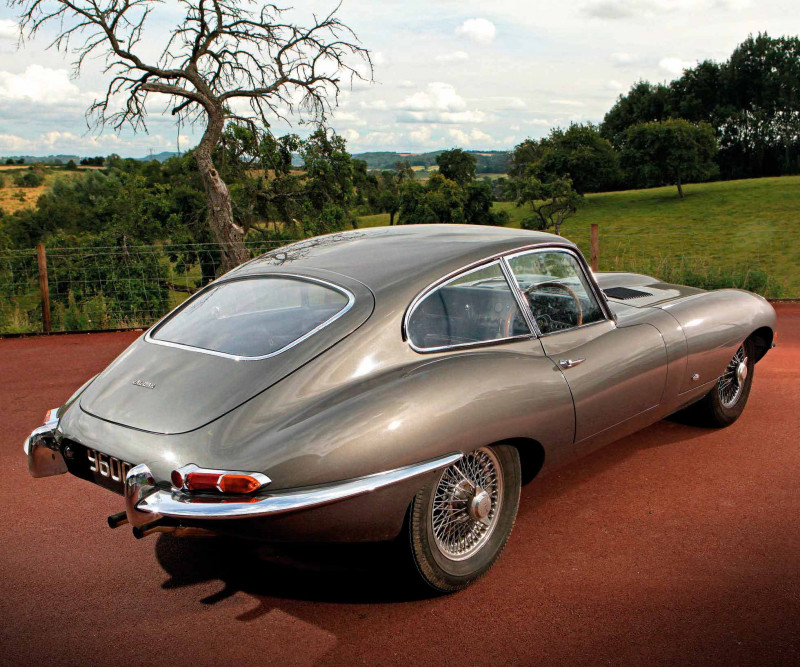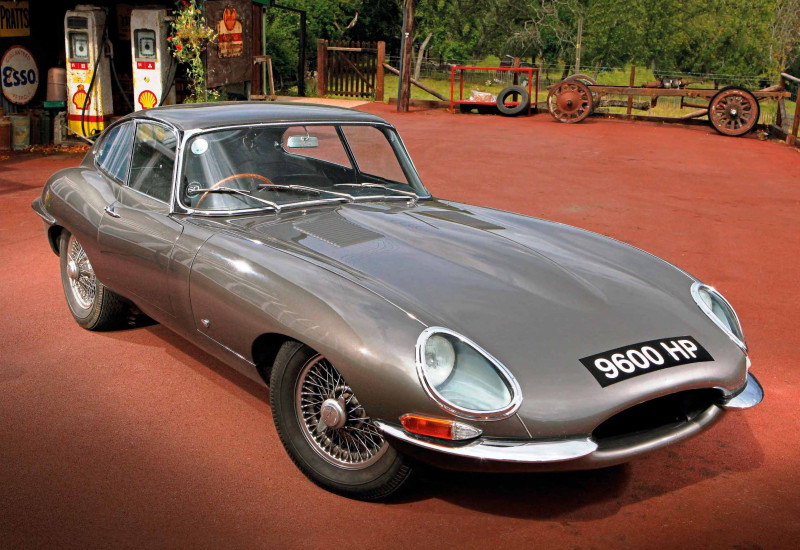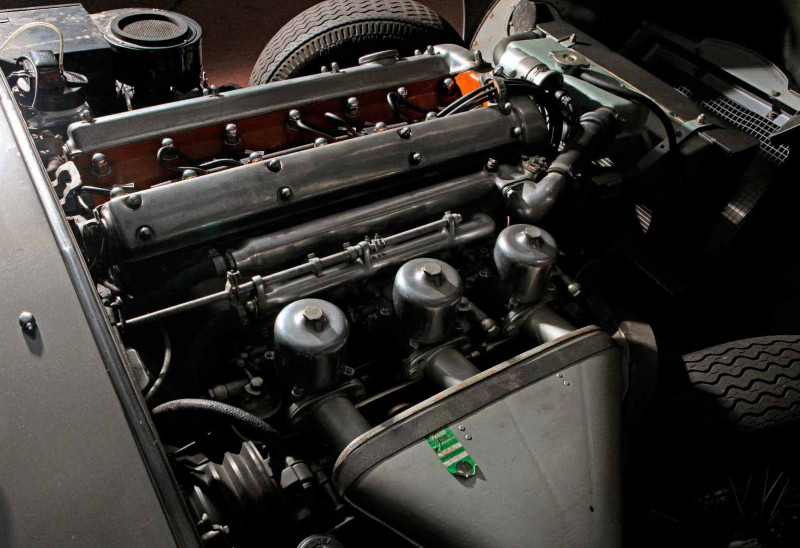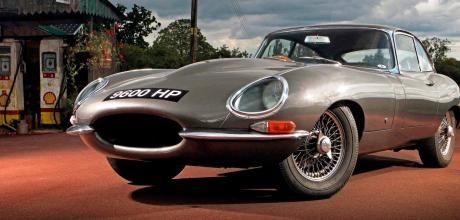1961 Jaguar E-type FHC - chassis no 7 oldest known surviving example
It might be one of most important Jaguars ever built, but the career of 9600 HP hasn’t all been about fame and fortune. Richard Gunn tells the tale of the rise, fall and rise again of the world’s oldest E-Type FHC. Words Richard Gunn. Photos Gerard Hughes.
GENEVA LEGEND
We tell the story of E-type chassis no 7, the oldest known surviving example and one of the two demonstrators at the E-type’s 1961 Geneva Motor Show launch.

Stunning, isn’t it? While all E-Types have a lithe beauty to them rarely equalled by any other car, there’s a particular purity and elegance to the earliest ones that showcase the model as those who designed and engineered it always intended. However, this particular E-Type is even more special than most. Indeed, anybody with even a basic knowledge of classic Jaguars will recognise that the number plate 9600 HP pinpoints this Metallic Gunmetal Grey example as something out of the ordinary, even if the particulars might be unfamiliar. Like 77 RW, NUB 120, 848 CRY and BUY 1, it proudly bears a registration that has become famous, thanks to countless public and media appearances.
In the case of 9600 HP, it is a car that literally once stole the show, the one in question being the 1961 Geneva Motor Show. As one of the preproduction E-Types, it was the car that launched the E-Type at that event, later joined by its roadster sister – 77 RW – being epically driven out from England overnight by Norman Dewis.

It featured in publicity shots and brochures, was driven and reviewed by many of the prominent motoring magazines and newspapers of the day, had Stirling Moss (briefly) behind its wheel and was owned by a film producer and a racing driver.
“THE ULTIMATE IRONY IS THAT I THINK I MUST HAVE BOUGHT 9600 HP WITHOUT EVEN SEEING IT”
Then, however, 9600 HP retired from the limelight. Not into Jaguar’s own heritage collection, as you might expect for such a seminal model, but into the hands of an enthusiast. And then another. It eventually passed to expert Jaguar guru, Philip Porter, who had it restored and returned it to the public eye. And that’s where it’s been ever since, as not just one of the most important Jaguars ever built but also one of the most significant vehicles created by any company anywhere. No wonder it justified the title of The Most Famous Car in the World in Porter’s book subsequent book.
The story of 9600 HP began with a single number: seven. That was its order in the E-Type prototype production run, and it would prove lucky for the car that was later registered as 9600 HP. While its older sisters were all scrapped, number seven would lead a rather more charmed life. It was built during the latter half of 1960 – it’s difficult to be more precise, as its early records no longer seem to exist – with the first reference to it being on November 4th, when the finished machine was introduced to another Jaguar legend, test driver Norman Dewis. His examination later that month found quite a few teething troubles with this second fixed-head coupé to be constructed (number six being its predecessor). Then it was time to drive it. Properly.
“IT’S UNLIKELY IT WAS ANYTHING MORE THAN A SLEEK GREY FLASH TO THOSE IN THEIR FORD ANGLIAS AND AUSTIN A40S POTTERING ALONG THE SAME STRETCH OF M1”
In those days, the unregulated motorways proved handy test tracks for British car firms, something that would eventually lead to the imposition of the blanket 70mph speed limit. That’s hardly surprising, of course, with Dewis unleashing the car on the new M1 stretch between Northampton and Newport Pagnell at speeds of up to 143mph during 1960’s final days.

It’s perhaps even more astonishing to us now, when prestigious new vehicles are such closely-guarded secrets, that such an epochdefining machine as the E-Type should be on such public display several months its official unveiling. That said, it’s unlikely that it was anything more than a sleek grey flash to those in their Ford Anglias and Austin A40s pottering along the same stretch of M1 at well under half the E-Type’s velocity. “We used to use the M1 for doing the maximum speed test,” recalled Dewis later. “Very often we would be doing 150 and other cars were there as well doing some very high speeds, Aston Martins and other firms. It was a very useful place to do maximum speeds.”
More serious testing was undertaken at the Motor Industry Research Association (MIRA) track near Nuneaton in Warwickshire, with various tweaks being tried to break the magic 150mph barrier. When aerodynamic adjustments failed, an ‘experimental’ engine was fitted – which proved rather more capable of reaching the magic ton and a half.
PRESS EXPOSURE
The Jaguar was registered 9600 HP on February 10th, 1961, after which the E-Type found itself loaned out to motoring journalists. Maurice Smith and Peter Riviere of The Autocar were the first to coax just over 150mph out of it, in Belgium, despite a passenger door flying open and some trim coming adrift. By the time the Daily Telegraph, Motor Sport, Autosport, the Daily Express, Sports Car Graphic, The Times and the BBC had all had their turn, a new engine was required – which was actually its original one, albeit rebuilt and, no doubt, also somewhat breathed upon.
On March 14th, 9600 HP set out from Coventry for Geneva in Switzerland, where the press day of the Geneva Motor Show was due to take place the following day, with the show opening to the public on the 16th. Jaguar’s PR manager, Bob Berry, was the lucky person chosen to take it out there from Coventry. And while his trip would be overshadowed by Norman Dewis’ overnight dash to Switzerland in E-Type roadster 77 RW a few days later, he still had to drive flat-out to get there, running at triple-digit speeds whenever possible and reputedly averaging 62mph from Calais. He arrived at the Parc des Eaux Vives venue with just twenty minutes to spare, to be met by a somewhat annoyed Jaguar boss, Sir William Lyons, exclaiming “Good God, Berry, I thought you’d never get here.”
The E-Type was the undoubted highlight of the show, with even Enzo Ferrari being forced to admit that it was “the most beautiful car ever built”. Such was the clamour for journalists and potential customers to sample it on a nearby hillclimb course that Dewis and 77 RW had to be summoned, just to give Berry a break. With an unofficial contest on to beat the more expensive Ferraris and Mercedes-Benz over the course, there were some pretty shaken and whitefaced passengers. Nevertheless, orders began to flood in, and by the end of the show, over 500 had been taken. The first was from the French actor, Jacques Charrier; perhaps a new E-Type was some consolation for being estranged from his wife, who happened to be Brigitte Bardot.
On its return to the UK, 9600 HP went back to its previous role as a press car; after its stardom in Geneva, it was a machine that everybody wanted to try. It was also photographed for brochures and advertisements, and found itself taking part in marketing stunts. When Britain’s first automatic car wash opened in London in June 1961, 9600 HP was the ‘first’ car through, with Stirling Moss inside. For the purposes of publicity, it was pretended he’d just bought it. “The shortest drive I ever had,” remembered Moss. Actually he did it twice, ‘re-opening’ the car wash again in the afternoon following its actual morning debut.
NEW OWNER
By May 1962, 9600 HP’s usefulness to Jaguar had come to an end and it was passed onto the prominent Jaguar dealership, Coombs of Guildford. According to Bob Berry, there were no thoughts of Jaguar keeping it for itself, despite the car’s historic stature. In turn, Coombs sold it to film and TV director, John Paddy Carstairs, who (among his many other efforts) helmed Norman Wisdom’s first six films and also directed Roger Moore in The Saint. He kept it for three years (during which Wisdom was a no doubt entertaining passenger), after which it went to the racer, Jack Fairman. The former Jaguar driver had seen it at a London dealer, realised its fame from the number plate, and picked it up cheaply during June 1965, as the garage didn’t have any idea of its past. His exploits with 9600 HP included a 100mph car chase with the police.
The E-Type’s next custodian was David Lockhart Smith, an architect, who acquired it during 1969, after the 45,000-mile car had been advertised for £975. By now, 9600 HP was beginning to show its age and needed some substantial work before Lockhart Smith could MoT it in the October of that year. However, it proved unreliable and subsequently saw little use well into the 1970s. Contact was made with Jaguar, now mired in its British Leyland era, to see if it wanted it back, but the company politely declined.
The car was passed onto to another owner (probably a trader) and then quickly sold again during the opening months of 1976, this time to an enthusiast, Derek Brant. He started to have it restored but had a change of heart when he found religion and God recommended he sell it. The Lord probably had a good point and definitely some divine insight, because the rebuild that Brant had started seemed to be proving difficult for the garage enlisted to do it.
E-TYPE SAVIOUR
At that point, Philip Porter came on the scene as the saviour of 9600 HP. Porter is, of course, one of the best-known names associated with classic Jaguars, and it was another prominent expert enthusiast, Paul Skilleter, who had alerted him that 9600 HP was for sale, following a magazine photo shoot. The deal was done in May 1977, with 9600 HP’s new owner paying £2650 for it. Porter also acquired three other E-Types from Brant, including 848 CRY, the red roadster that featured in The Italian Job and which stars elsewhere in this publication. “The ultimate irony is that I think I must have bought 9600 HP without even seeing it,” Porter admitted.
If restoring one early E-Type is a difficult, painstaking and expensive task, restoring four must border on very pricey insanity; and so the cars, along with Porter’s collection of other Jaguars, sheltered in a large barn while the Jaguar-focused writer and author concentrated on other projects. Life often gets in the way of the really important stuff, but by 1999 the time finally seemed right to make a start on returning 9600 HP to the road. The job was entrusted to Classic Motor Cars of Bridgnorth in Shropshire, with the emphasis on trying to preserve as much as possible of what was quite a different machine compared to the main production models. This included an aluminium tailgate, Perspex rear window and numerous holes where things had been attached and removed over the years. While the renovation continued, Porter tried to uncover as much history of the car as possible, tracking down many people associated with it.
The task of bringing 9600 HP back to life took eleven months in total, its completion being celebrated by a brief visit from the BBC TV Top Gear team followed by a run to Geneva – exactly 39 years to the day after Bob Berry had done the same journey. What a way to start the 21st century! This latest trip to Switzerland was undertaken at a somewhat more pedestrian pace than in 1961, however, as there was no irate Sir William waiting at the other end. But the destinations were the same; the Parc des Eaux Vives and the hillclimb where the 9600 HP had so impressed so long ago.
That was twenty years ago, of course, since when the oldest surviving E-Type FHC has not only been lovingly cared for, but has also been regularly used, enjoyed and exposed to the world. The word ‘iconic’ is used far too much these days, but in the case of 9600 HP it’s just one of many superlatives that are completely justified to describe this mother of all E-Types. Long may it continue to delight, astonish and beguile all those who see it… just as it did at Geneva almost six decades ago.
“THE FORMER JAGUAR DRIVER HAD SEEN IT AT A LONDON DEALER, REALISED ITS FAME FROM ITS NUMBER PLATE, AND PICKED IT UP CHEAPLY DURING JUNE 1965”


